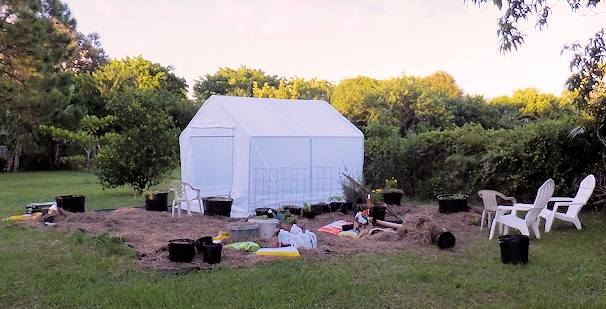How Does Your Greenhouse Grow?
I mentioned in the previous post that I was the delighted recipient of a greenhouse, which I would be using for my Fall gardening. So let’s talk a little about greenhouse gardening in general, and peppers in particular!
Greenhouse, Growhouse – What’s the Difference?
I don’t guess there’s a ton of difference between a “greenhouse” and a “growhouse”, but here’s how I make the distinction. A greenhouse is typically a structure that is solidly anchored to the ground, with glass or transparent polycarbonate panels. A growhouse is a structure that is movable, but that can be anchored to the ground. It usually does not have glass, but a transparent or translucent enclosure.
(By that description, I have a “growhouse”, although mine is securely anchored to the earth.)
Still, I’ll use the term “greenhouse” through the rest of this post, as they are pretty much used the same, and that is for growing plants in a controlled environment. They can be have beds of soil in the ground, raised beds, containers or hydroponics. Not to mention all kinds of combinations!
Why Use a Greenhouse?
It’s pretty obvious that in a colder climate that one really good reason for “plants under glass” is to extend the growing season. If you live in a part of the world that gets less than 90 frost-free days, you’ve got a short planting season, which limits what you can bring to harvest. Or, you may be in a very windy location, with extremes of heat and cold.  Could be that you’re like me and it’s almost too hot and wet during parts of the year for good growth.

The start of setting up the greenhouse (still a long way to go in setting up all the containers and cleaning up). The cover looks white from a distance, but inside it’s translucent and very bright.
There are lots of reasons for using a greenhouse, and as an FYI, they don’t have to be expensive! I know, I love the looks of some of the decor greenhouses, with fieldstone or cedar and huge expanses of glass. They can run from $800 up to $20,000+.
I don’t have that kind of money, so I went the inexpensive route — the 10’x10′ greenhouse, anchors and misting system all together were around $300. OK, I forgot to include the ground cloth (add an extra $40), but that was a personal choice, since I am going with using containers.
 Peppers Under Glass
Let’s talk growing peppers now. As you probably know, peppers love the heat and do best in a warm climate. I have to admit, Southern Florida is warm, and sometimes even my plants melt in the heat in the middle of July. While I have grown peppers outside in the winter, they typically languish around until the nights are consistently above around 50 degrees F.
(I had one bell pepper plant that set a small pepper in January and if that fruit got any bigger during February, I couldn’t tell. But come the middle of March, all the sudden that fruit got larger and larger and then the plant exploded with new growth and more flowers and fruit.)
I was in the greenhouse this weekend with the door and window open and it was plenty hot — I had to turn on the misting system to take the temperature down a notch. This winter, I should be pretty easily be able to maintain 50+ degrees at night, after closing the the door and window and even moving in gallon bottles of sun-warmed water on the nights when it’s especially chilly. (Worst comes to worst, I can always get a space heater and keep the plants company, LOL.)
I don’t have any peppers moved in yet (the greenhouse was a surprise), but I do have some pepper seeds started in it. I may have to break down and get myself a pepper plant from the lawn and garden shop, so I can fuss over it while waiting for the current seeds to germinate. 😉
Let There Be Light!
If you decide that you want to explore getting a greenhouse and you live north of, say, Georgia, you may also have to think about supplemental lighting. Me, even during the winter I get 9 or 10 hours of sunlight, but most people aren’t that lucky. And when you can’t provide your pepper plants with at least 6 hours of sunlight a day, your plants are not going to thrive.
Fortunately, fluorescent lighting has gotten fairly inexpensive. The problem can be where your greenhouse is in relation to an electrical outlet! If you’re in a structure attached to your house, you’re in luck. If not, you’ll have the expense of running a line out to the greenhouse.
So how does your greenhouse grow?
